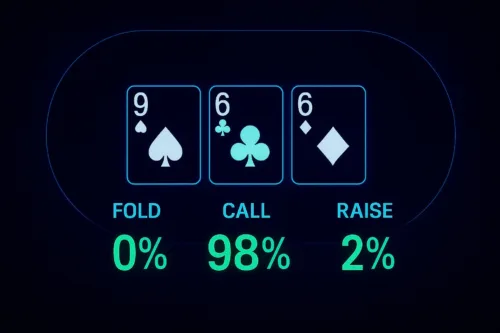It’s natural poker instinct to slowplay our monsters. And most of the time, it’s the right strategy. However, using poker solvers to analyze these spots brings up some fascinating elements that will no doubt help us take unconventional lines that can be highly profitable. Let’s take a look at one example of flopping a monster and see what happens when we stray from the common path.
In this hand, you’re in the middle stages of a tournament with 50bb and raise 99 second to act. Only the button calls. The flop comes 966, giving you an almost invincible hand. Being out of position, you decide to check your option. Your opponent takes the bait and makes a small bet. This is a spot where I see many players just call—and the solver doesn’t disagree, preferring to call with 66% of its range. And with our specific hand, top-boat, it chooses to just call a whopping 98% of the time.
But what about that remaining 2%? How does it choose to play it and are there any reasons to expand that frequency in specific scenarios?
When the solver does choose to bet our hand, it does so by sizing down to just 6bb.
By following its lead and check-raising a small size, we not only begin building a pot with our strongest holding, but we put our opponent in a situation where they have to continue with nearly their entire range.
In fact, the only types of hands that predominantly fold against this raise are offsuit broadways like QJ and JT, low suited aces like A2-A4, and low suited connectors like 54s and 53s. Taking into account that most of your opponents won’t have the full collection of those hands in this line (flatting an early position raise on the button and then firing a bet when checked to), that means their range is loaded with hands that are now forced to call. The solver confirms this by continuing against the raise with more than 70% of the hands it bet.
Every single top pair calls, all the good aces, all pocket pairs, every straight draw, and even most backdoor flush draws. All of them continue at a high frequency, all while either drawing extremely thin or already completely dead.
Continuing the example, after your opponent calls, the turn brings a 4, putting a flush-draw on the board. Once again, the solver prefers to check our exact hand, this time 95% of the time. But it’s important for us to remember that it’s doing so under the assumption that its opponent plays in an unexploitable way as well. In reality, most of your opponents, especially those in low-stake or live settings, are far likelier to be too passive on this board than too aggressive. And against another small bet (the solver prefers about a quarter-size bet when it does bet) your opponent is once again forced to call or raise the majority of their range. In fact, it only folds a minuscule 15% of the time, even though it’s now faced a check-raise and double-barrel!
Your opponent goes ahead and does make the call, as they will 85% of the time, and the river brings a suited 8, completing the backdoor flush draw.
The solver once again prefers to check 99, but it now doubles its betting frequency to 10%. However, the problem most players face here is they get too greedy and shove, allowing their opponent to fold the nearly 60% of the time the solver says they should—a number that is likely lower than what we can expect to see in low stakes games where players massively overfold to big river bets.
Instead, when the solver does choose to bet top boat here, it continues its small-ball approach, only betting about 1/3 pot on this river. In doing this, it not only guarantees getting value from the vast majority of its opponent’s weakest holdings (most of which will have a tough time not making a crying call when getting such incredible pot odds), but also opens the door for them to include some bluff-shoves in their range that would have otherwise snap-folded to a jam.
So regardless if you prefer to check-raise this particular hand or not, the lesson here is important: when you flop a monster, don’t automatically default to check-calling. Instead, take the time to assess the situation and remind yourself that check-raising on the flop can set up a chain of decisions where your opponent is all but forced to continue putting money in with the worst of it. And by keeping your bets small throughout the hand, especially on the river, you can extract maximum value from the largest part of your opponent’s range.
I don’t know about you, but that sounds like a strategy I can get behind!



